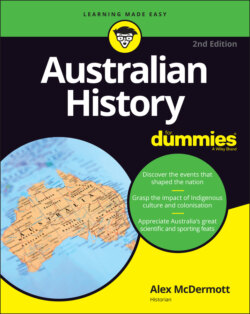Читать книгу Australian History For Dummies - Alex McDermott - Страница 34
Life in Aboriginal Australia
ОглавлениеFind a carpenter’s tape measure. Pretend each centimetre equals ten years. Unreel the tape measure and look at the very first 22 centimetres — that’s the entire history of European settlement in Australia. Now (in a good long room and if your tape is long enough) unreel the tape measure to 50 metres — that’s a conservative estimate of the length of Aboriginal history (or 5,000 years). Some scientists argue that, based on archaeological evidence, Aboriginal people arrived in Australia at least 65,000 years ago.
The Europeans who first encountered the Australian Aboriginals observed that they had no agriculture, no domestic livestock and didn’t appear to wash. To the European way of thinking, this made them a primitive people, unchanged since the Stone Age. Those same Europeans might have asked themselves, when the wind killed their crops and their wells ran dry, how these ‘primitive’ people had managed to survive for so long in such a harsh landscape — without the aid of tinned food and sacks of British grain.
Evidence exists of trade and cultural exchange between Aboriginal peoples and South-East Asians dating back thousands of years, so it can hardly be likely that Aboriginals were unaware of agriculture. They simply had little use for it in the dry, unfertile soils of their home. Agriculture was unsuited to Australia’s grasslands and deserts (some argue agriculture still is, despite all the water and modern fertilisers we can throw at it), so Aboriginal communities predominately survived by hunting and gathering, managing resources extremely prudently — and maintaining their population at a sustainable level. While they did grow crops of tubers such as yams, grain such as native millet, macadamia nuts, fruits and berries, their farming has been described as an activity rather than a lifestyle.
Although Aboriginal Australians didn’t undertake large-scale agriculture, they did develop techniques that helped control their environment. One of these techniques is now known as firestick farming. Aboriginal people used fire in a deliberate and systematic way to clear undergrowth and encourage regrowth to attract fauna, as well as to flush out game. (For more on their lifeways, and how this affected the modern Australian landscape, see the sidebar ‘Shaping Australia with nomadic lifeways’.)
The Aboriginals were careful not to damage the fragile web of ecological relationships that sustains life on this dry island, because they depended on the web for survival. (And, incidentally, they didn’t wash much because they were well aware that water was too valuable to waste — something all Australians have been learning recently.) When the Europeans landed, Aboriginal peoples actually had a better life expectancy than the colonists, as well as almost no instances of the ‘modern’ diseases — tooth decay, heart disease, tuberculosis and cancer. The effectiveness of their resource management (such as the controlled burns to increase hunting pasture) gave them far more leisure time than the arriving agriculturalists, which equalled time to play, talk and dream. That’s right — the original affluent society.
This isn’t to make the mistake of romanticising the tougher elements of Aboriginal life. Records suggest that even infanticide (killing newborn babies) was carried out in some cultural or tribal groups to ensure sustainable population levels. Deaths from tribal warfare and feuds were relatively commonplace. Life was no picnic. Aboriginals needed to make hard choices and ruthless decisions simply to survive, as well as develop infinite resourcefulness and adaptability. But no-one can deny that, survival-wise, the Aboriginal way of life was a tremendous success. Aboriginals have managed to maintain a continuous culture through millennia, which is something no other people — anywhere — has achieved.
